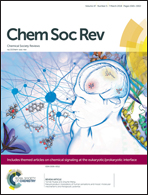Engineering chemical interactions in microbial communities
Abstract
Microbes living within host-associated microbial communities (microbiotas) rely on chemical communication to interact with surrounding organisms. These interactions serve many purposes, from supplying the multicellular host with nutrients to antagonizing invading pathogens, and breakdown of chemical signaling has potentially negative consequences for both the host and microbiota. Efforts to engineer microbes to take part in chemical interactions represent a promising strategy for modulating chemical signaling within these complex communities. In this review, we discuss prominent examples of chemical interactions found within host-associated microbial communities, with an emphasis on the plant-root microbiota and the intestinal microbiota of animals. We then highlight how an understanding of such interactions has guided efforts to engineer microbes to participate in chemical signaling in these habitats. We discuss engineering efforts in the context of chemical interactions that enable host colonization, promote host health, and exclude pathogens. Finally, we describe prominent challenges facing this field and propose new directions for future engineering efforts.

- This article is part of the themed collection: Chemical signaling at the eukaryotic/prokaryotic interface


 Please wait while we load your content...
Please wait while we load your content...